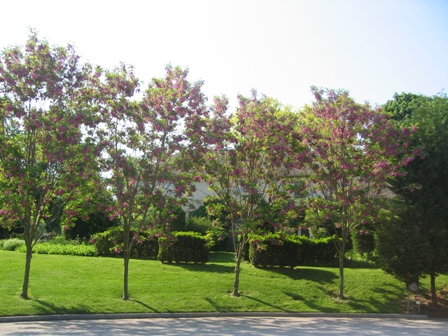I’m a pretty intense gardener. So when I love a certain specimen, I tend to use it with great abandon in my garden. Such was the case with Robinia pseudoacacia ‘Frisia’ and ‘Purple Robe’.
I first came across this specimen on a trip to London in late spring, close to two decades ago. I was taken aback by its delicate, lime colored leaves in contrast with all of the green plant material around the base of its trunk. I made note of it and knew that at some point in the development of my garden that I would find a use for at least one robinia.
That happened in 1991 when my garden went through a major renovation: I transformed a steep sloping hillside into a garden with three levels by building extensive retaining stone walls. With two wide island beds on the left side of the steps at the top level, I felt that a strong statement was needed as a focal point as one walked upwards.
In researching robinias, I discovered that they were extremely fast growers that could thrive in poor, dry soil. At maturity, they were 30-50 feet tall and are hardy in USDA Zones 4-9.These would fit perfectly in my garden, so I thought.
I decided to plant 3 Robinia pseudoacacia ‘Frisia’ on either side of the steps in a triangular shape. I ordered them from Gossler’s Nursery (www.gosslerfarms.com) in Oregon, a terrific source for unusual shrubs and trees.
Over the next 2 years, these 6 trees bloomed into a canopy of magnificent yellowish/chartreuse blooms in the spring, followed by racemes of large, fragrant white flowers. Because the trees were only 5-6 feet tall at this time, one really felt covered by their beauty when perched at the top of the staircase. After the flowers bloomed, the trees became inundated with seed pods.
I thought to myself, “If I have a good thing, why not add more where needed”. In a long extended sweeping bed abutting my neighbors property line with evergreens acting as the buffer point, I planted three more Robinia pseuocacia ‘Frisia’, siting them in scale to the 6 already planted.
For the first 5 years of their life, I absolutely loved my robinias. Yes, they were a bit of a nuisance when a storm hit. These specimens are composed of thin, brittle branches that in a somewhat windy storm break off and land all over the garden.And when their fragrant flowers turned into seed pods, although they retained their lime color, their startling beauty faded to ‘just another tree with delicate leaves’.
At the same time that I planted one set of robinias, I bought one for Chanticleer Garden, a public pleasure garden in my neighborhood, as a gift for the garden. Over the years, the gardeners have kept it pruned as a medium sized, free form shrub in a herbaceous border and it looks stunning, much like a Catalpa bignoides ‘Aurea’ (Indian Bean Tree) does.
And because my steep front yard was in need of some delicate curb trees, I began to research out other robinias. In the rose garden at Hidcote in late May, I had seen some Robinia hispida (bristly locust) shrubs interspersed with a plethora of roses and perennials. Its delicate, rose-pink blooms were delightful. Consequently, when I found Robinia pseudoacacia ‘Purple Robe’ in Greer Garden’s catalogue (www.greergardens.com), I thought I had found a winner and immediately order 4 of them.
Again, within 2 seasons, their spring bloom with dark green leaves in the spring, along with purplish/pink pendant shaped racemes of blooms was a knock out. People walking or driving by would literally stop and stare at them.
OK, so now I’ve given you the history of my relationship and love affair with these seductive trees. Let me tell you the down side of their personalities. Because they are so spiny and brittle and as they have become larger, more than a few branches, some of them major, break off of the tree. Secondly, their fast growth is problematic. Since I don’t buy into the theory of topping off trees, I have been unable to keep their canopy in the back area, low and welcoming. Thirdly, the shape of the trees had to be altered over several years of pruning. That is because so many of the lower branches broke off, many remaining ones were pruned to make the trees symmetrical in appearance. There now exists no sense of a canopy and the branches are so high that the only place one can view the beauty of these trees are on the lower levels.
And finally, their worst characteristic is a tendency to seed themselves any and everywhere. The first few times this happened, I thought,” How charming, I can give some small trees to my friends.” But each season, I have pulled out at least 2 dozen small trees (in borders and in my grass), along with cutting back dozens on the edge of my woodland that have become humongous. Whether or not they are labeled invasive, I don’t know. But I personally do label as an invasive species.
Would I use these trees in my garden again? Absolutely not! The only circumstance where I would use them is as Chanticleer did: as a standout shrub in a herbaceous border. Perhaps then one could keep this wild specimen under control while still enjoying its gorgeous color and delicious blooms!



